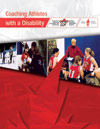 Coaching Athletes with a Disability is a manual designed to provide grassroots coaches who have never worked with athletes with a disability with basic information, guidelines, and tips that will assist in creating conditions for effective participation and inclusion. Check out the #CoachTop10 highlights of this great resource.
Coaching Athletes with a Disability is a manual designed to provide grassroots coaches who have never worked with athletes with a disability with basic information, guidelines, and tips that will assist in creating conditions for effective participation and inclusion. Check out the #CoachTop10 highlights of this great resource.
10. Athletes with a disability often travel with additional equipment, which can include tapper sticks and guide dogs for the visually impaired, wheelchairs for quadriplegics and paraplegics, and additional prosthetics for amputees. In airports, for example, a wheelchair repair kit may not be popular with security officials these days.
9. When interacting with persons with intellectual impairment, treat individuals as such. Address the person directly, not his or her assistant or guardian. Ask questions that can be answered by YES or NO. Give clear and simple information, and repeat as necessary. Be patient.
8. Coaches who encounter overprotective parents may communicate that their child has the same rights as anybody else to participate in sport and enjoy its challenges and risks. Once the child is on the playing field, the goal is for the parents to discover the values of sport in social development — the increased discipline, teamwork, self-esteem, social interaction, and social responsibility of the child.
7. “You’re not there to be a nurse or a helper,” says Peter Eriksson, the first Canadian wheelchair athletics coach to reach Level 4 certification in the National Coaching Certification Program in track and field. “It’s important to do what you would with any other athlete at first.”
6. Sit down when talking to a person in a wheelchair. It can give the impression of an air of superiority if you are standing while in conversation with a person in a wheelchair.
5. Whether adaptation occurs on a recreational or a competitive level, a key principle to keep in mind is to adapt only if necessary. Needless to say, it must always be the sport or the activity that is adapted, not the person with a disability.
4. “It must be athlete and sport first,” says Patrick Jarvis, former president of the Canadian Paralympic Committee. “For example, the mindset should be that this person is a sprinter who happens to be an amputee.”
3. Find out more about the disability. Coaches should aim to develop a reasonably good understanding of the disability or disabilities of the athletes that they coach. This information should include specific safety considerations.
2. Rather than speculating about the athlete’s sport capabilities, coaches should engage in a frank dialogue with the athlete.
1. "Look at coaching athletes with a disability as an opportunity for you as a coach to enhance your coaching abilities and knowledge of your sport,” says Chris Bourne.
Click here to access the Coaching Athletes with a Disability manual.

